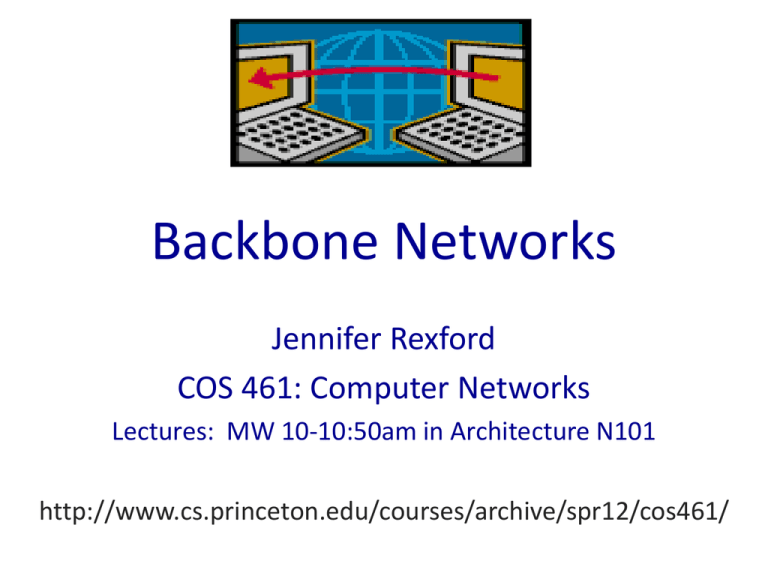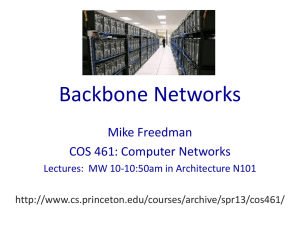Backbone Networks Jennifer Rexford COS 461: Computer Networks
advertisement

Backbone Networks Jennifer Rexford COS 461: Computer Networks Lectures: MW 10-10:50am in Architecture N101 http://www.cs.princeton.edu/courses/archive/spr12/cos461/ Networking Case Studies Data Center Enterprise Backbone Cellular Wireless 2 Backbone Topology 3 Backbone Networks • Backbone networks – Multiple Points-of-Presence (PoPs) – Lots of communication between PoPs – Accommodate traffic demands and limit delay 4 Abilene Internet2 Backbone 5 Points-of-Presence (PoPs) • Inter-PoP links – Long distances – High bandwidth Inter-PoP Intra-PoP • Intra-PoP links – Short cables between racks or floors – Aggregated bandwidth • Links to other networks Other networks – Wide range of media and bandwidth 6 Where to Locate Nodes and Links • Placing Points-of-Presence (PoPs) – Large population of potential customers – Other providers or exchange points – Cost and availability of real-estate – Mostly in major metropolitan areas (“NFL cities”) • Placing links between PoPs – Already fiber in the ground – Needed to limit propagation delay – Needed to handle the traffic load 7 Peering Customer B • Exchange traffic between customers Provider B – Settlement-free • Diverse peering locations multiple peering points – Both coasts, and middle • Comparable capacity at all peering points Provider A – Can handle even load Customer A 8 Combining Intradomain and Interdomain Routing 9 Intradomain Routing A 3 4 D 8 10 3 8 F 5 B 9 E 4 G C • Compute shortest paths between routers – Router C takes path C-F-A to router A • Using link-state routing protocols – E.g., OSPF, IS-IS 10 Interdomain Routing • Learn paths to remote destinations – AT&T learns two paths to Yale • Applies local policies to select a best route Sprint AT&T Tier-2 Tier-3 Yale 11 An AS is Not a Single Node • Multiple routers in an AS – Need to distribute BGP information within the AS – Internal BGP (iBGP) sessions between routers AS1 eBGP iBGP AS2 12 Internal BGP and Local Preference • Both routers prefer path through AS 100 • … even though right router learns external path AS 200 AS 100 AS 300 Local Pref = 100 AS 256 13 Local Pref = 90 I-BGP Hot-Potato (Early-Exit) Routing • Hot-potato routing – Each router selects the closest egress point – … based on the path cost in intradomain protocol • BGP decision process – Highest local preference – Shortest AS path – Closest egress point A – Arbitrary tie break 4 dst 3 D 8 C 14 hot potato 8 10 3 F 5 B 9 E 4 G Hot-Potato Routing Customer B • Selfish routing – Each provider dumps traffic on the other – As early as possible Provider B multiple peering points • Asymmetric routing Early-exit routing Provider A Customer A – Traffic does not flow on the same path in both directions Joining BGP and IGP Information • Border Gateway Protocol (BGP) – Announces reachability to external destinations – Maps a destination prefix to an egress point • 128.112.0.0/16 reached via 192.0.2.1 10.1.1.1 192.0.2.1 16 Joining BGP and IGP Information • Interior Gateway Protocol (IGP) – Used to compute paths within the AS – Maps an egress point to an outgoing link • 192.0.2.1 reached via 10.1.1.1 10.1.1.1 192.0.2.1 17 Joining BGP with IGP Information 128.112.0.0/16 Next Hop = 192.0.2.1 128.112.0.0/16 10.10.10.10 AS 7018 192.0.2.1 IGP destination next hop 192.0.2.0/30 10.10.10.10 Forwarding Table destination next hop + BGP destination next hop 128.112.0.0/16 192.0.2.1 18 128.112.0.0/16 192.0.2.0/30 10.10.10.10 10.10.10.10 AS 88 Interdomain Routing Policy 19 Selecting a Best Path • Routing Information Base – Store all BGP routes for each destination prefix – Withdrawal: remove the route entry – Announcement: update the route entry • BGP decision process – Highest local preference – Shortest AS path – Closest egress point – Arbitrary tie break 20 Import Policy: Local Preference • Favor one path over another – Override the influence of AS path length • Example: prefer customer over peer Local-pref = 90 Sprint AT&T Local-pref = 100 Tier-2 Tier-3 Yale Import Policy: Filtering • Discard some route announcements – Detect configuration mistakes and attacks • Examples on session to a customer – Discard route if prefix not owned by the customer – Discard route with other large ISP in the AS path AT&T Princeton 128.112.0.0/16 USLEC Export Policy: Filtering • Discard some route announcements – Limit propagation of routing information • Examples – Don’t announce routes from one peer to another – Don’t announce routes for management hosts UUNET AT&T Princeton 128.112.0.0/16 Sprint network operator Export Policy: Attribute Manipulation • Modify attributes of the active route – To influence the way other ASes behave • Example: AS prepending – Artificially inflate AS path length seen by others – Convince some ASes to send traffic another way AT&T 88 88 USLEC Sprint Princeton 128.112.0.0/16 88 Business Relationships • Common relationships – Customer-provider – Peer-peer – Backup, sibling, … • Implementing in BGP – Import policy • Ranking customer routes over peer routes – Export policy • Export only customer routes to peers and providers BGP Policy Configuration • Routing policy languages are vendor-specific – Not part of the BGP protocol specification – Different languages for Cisco, Juniper, etc. • Still, all languages have some key features – List of clauses matching on route attributes – … and discarding or modifying the matching routes • Configuration done by human operators – Implementing the policies of their AS – Business relationships, traffic engineering, security Backbone Traffic Engineering 27 Routing With “Static” Link Weights • Routers flood information to learn topology – Determine “next hop” to reach other routers… – Compute shortest paths based on link weights • Link weights configured by network operator 2 3 2 28 1 1 1 3 5 4 3 Setting the Link Weights • How to set the weights – Inversely proportional to link capacity? – Proportional to propagation delay? – Network-wide optimization based on traffic? 2 3 2 29 1 1 3 1 3 5 4 3 Measure, Model, and Control Network-wide “what if” model Topology/ Configuration Offered traffic Changes to the network measure control Operational network 30 Limitations of Shortest-Path Routing • Sub-optimal traffic engineering – Restricted to paths expressible as link weights • Limited use of multiple paths – Only equal-cost multi-path, with even splitting • Disruptions when changing the link weights – Transient packet loss and delay, and out-of-order • Slow adaptation to congestion – Network-wide re-optimization and configuration • Overhead of the management system 31 Constrained Shortest Path First • Run a link-state routing protocol – Configurable link weights – Plus other metrics like available bandwidth • Constrained shortest-path computation s – Prune unwanted links (e.g., not enough bandwidth) 3, bw=80 – Compute shortest path on the remaining graph 32 5, bw=10 d 5 bw=70 6, bw=60 Constrained Shortest Path First • Signal along the path s – Source router sends a 3, bw=80 message to pin the path to destination – Revisit decisions periodically, in case better options exist 5, bw=10 d 5, bw=70 6, bw=60 1: 7: 20 20: 14: 78 2: 7: 53 link 7 53: 8: 42 1 link 14 2 33 link 8 Challenges for Backbone Networks 34 Challenges • Routing protocol scalability – Thousands of routers – Hundreds of thousands of address blocks • Fast failover – Slow convergence disrupts user performance – Backup paths for faster recovery – E.g., backup path around a failed link 35 Challenges • Router configuration – Adding customers, planned maintenance, traffic engineering, access control, … – Manual configuration is very error prone • Measurement – Measuring traffic, performance, routing, etc. – To detect attacks, outages, and anomalies – To drive traffic-engineering decisions 36 Challenges • Diagnosing performance problems – Incomplete control and visibility – Combining measurement data • Security – Defensive packet and route filtering – Detecting and blocking denial-of-service attacks – DNS security, detecting and blocking spam, etc. • New services – IPv6, IPTV, … 37 Conclusions • Backbone networks – Transit service for customers – Glue that holds the Internet together • Routing challenges – Interdomain routing policy – Intradomain traffic engineering • Next time – Cellular data networks (guest lecture) 38





